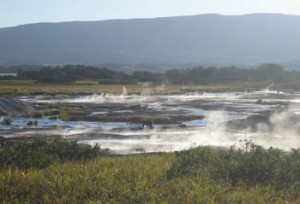Jul
11
A Bacterium that Makes Hydrogen from Cellulose
July 11, 2008 | 5 Comments
Elizaveta Bonch-Osmolovskaya and her colleagues at the Winogradsky Institute of Microbiology of the Russian Academy of Sciences discovered the rare archaeon, a kind of ancient bacteria called Desulfurococcus fermentans, in the Uzon Caldera on the Kamchatka Peninsula, an isolated spit of land in eastern Siberia that is full of volcanoes and their remnants. D. fermentans degrades cellulose from the higher plants that fall in the caldera. When news of the successful isolation and description of the microorganism’s activity reached Biswarup Mukhopadhyay, an assistant professor with the Virginia Bioinformatics Institute at Virginia Tech he saw the chance to create an organism that produces hydrogen from a cellulose feedstock at high temperatures. A team of scientists from across the world have now teamed up to unlock the process and the U.S. Department of Energy Joint Genome Institute will expedite the research by sequencing the organism for comparative genomic research.
This discovery is just what Mukhopadhyay had been hoping for as his lab is specialized for very high temperature or hyperthermophilic archaea and in energy production. The idea that a bug can eat cellulose and exhale hydrogen directly is in fact living must have been great news. It seems the four closest relatives of this organism don’t do this at all; rather they reduce sulfur to hydrogen sulfide, the rotten egg smelling stuff.
This particular organism grows best at 176 to 180 degrees F (80-82 C) which is close to the boiling point of water which brings advantages, it’s faster and the bioreaction wouldn’t be contaminated by common microbes.
At the Thermophiles 2007 conference in Bergen, Norway, Mukhopadhyay discussed collaboration with Bonch-Osmolovskaya, Haruyuki Atomi of Kyoto University, and Todd Lowe of the University of California, Santa Cruz. He had similar conversations with Venkat Gopalan of the Ohio State University and Nikos Kyrpides and Iain Anderson of the U.S. Department of Energy Joint Genome Institute. Mukhopadhyay, with support from the team, submitted a proposal to sequence the genomes of D. fermentans and two of its cousins to the Joint Genome Institute’s Community Sequencing Program, which sequences the genomes of organisms relevant to Department of Energy missions at no charge. Organisms to be sequenced are selected from proposals based on scientific merit and the degree of interest by the scientific community.
In mid-June, the Joint Genome Institute approved the proposal titled “A Comparative Genomics Investigation on Hydrogen Production from Cellulosic Materials and Starch by a Hyperthermophilic Archaeon.” The researchers have six months to use the information before it is submitted to a gene bank for use by the world’s scientific community.
The Joint Genome Institute had already targeted another sulfur-reducing cousin of D. fermentans to fill in a gap in the Genomic Encyclopedia of Bacteria and Archaea. Mukhopadhyay says, “We will have genome information of D. fermentans that degrade cellulose and make hydrogen and similar information for three cousins that do not have these properties. We will perform genomic subtraction exercises to figure out which genes and regulatory circuits make D. fermentans so capable. These data will guide more intensive and focused investigations on the cellulose degradation and hydrogen production. This is just the beginning of an exploration of hitherto unknown processes with potential to advance energy production.”
“Advance energy (fuel) production” could be quite an understatement. Imagine making available large quantities of biomass based free hydrogen for fuel production. That could make fuel production a very different matter than worrying about oil prices.
Comments
5 Comments so far



Great site. A lot of useful information here. I’m sending it to some friends!
Hiya, I’m really glad I have found this information. Nowadays bloggers publish only about gossip and web stuff and this is actually irritating. A good blog with interesting content, that’s what I need. Thanks for making this site, and I’ll be visiting again. Do you do newsletters? I Can not find it.
Good! Thank you! I always wanted to write in my site something like that. Can I take part of your post to my blog?
Thanks for posting. Good to see that not everyone is using RSS feeds to build their blogs 😉
Awesome post. I so good to see someone taking the time to share this information